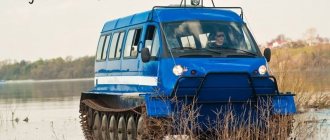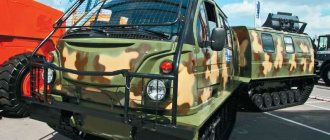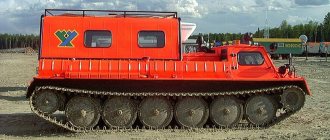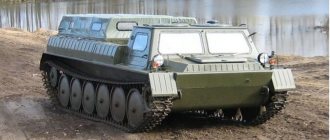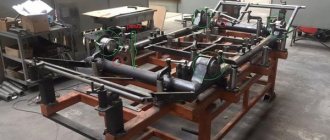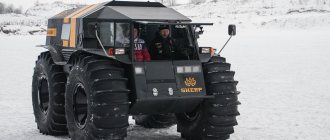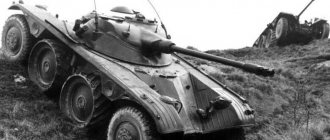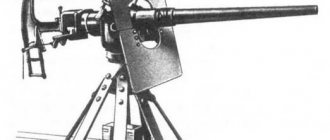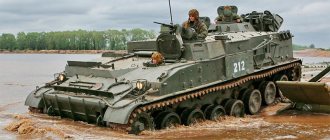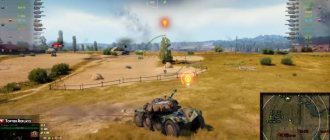Tracked all-terrain vehicles belong to a specific category of equipment that is not intended for use on public roads. Such vehicles are capable of moving not only off-road, but also through deep snow and even through swamps. This is an ideal option for professional hunters. Unfortunately, the price of tracked all-terrain vehicles is extremely high, so the purchase of such equipment is only available to very wealthy hunters. One of the most affordable options is the GAZ-47.
How the GAZ-47 all-terrain vehicle appeared
The Great Patriotic War clearly demonstrated that the cross-country ability of tracked vehicles is practically limitless. Having no experience in developing this kind of all-terrain vehicle, the Soviet geological industry increasingly insistently demanded the creation of a special all-terrain vehicle that could reach any hard-to-reach corner of the country.
In the 50s, the leading design bureaus of the USSR began to develop tracked all-terrain vehicles, as large-scale development of the northern regions of the country began.
Gorky designers managed to release the first model of a swamp vehicle in 1954. This model was tracked and was called GAZ 47 (GT-S). This model had:
Tracked tank platform (borrowed from light tanks of the T-60 and T-70 series); Cabin for the driver and passengers, which was located in the front; Separate compartment for the engine; Spacious cargo compartment.
The GAZ-47 model was produced until 1967.
Modifications of the first crawler transporter
To replace the GAZ-47 in 1968, its modification, the GAZ-71, rolled off the plant’s assembly line. On the new machine, the ground pressure indicators were improved from 0.19 to 0.17 kg/cm2. The car also received a new ZMZ-71 engine with a power of 115 hp. s., due to which the maximum speed increased to 50 km/h. The height of the vehicle in the cabin was reduced by 25 cm. The remaining changes turned out to be insignificant or remained at the same level. Just like its predecessor, the GAZ-71 was manufactured taking into account garage-free storage and operation in harsh climatic conditions with a temperature range from -40 - +50 degrees.
These changes and qualities were enough for the car to be produced unchanged until 1985.
The GAZ-47 was not deprived of its attention at the ZiL design bureau either. The modification they created received the GAZ-47 AMA index. The changes that ZiLovtsy made affected only the chassis, but they turned out to be cardinal. The tracks were replaced, which consisted of chains with rotating rollers attached to them. The rollers rolled on special supports that were welded onto the body of the conveyor body.
But the changes made did not justify themselves. The only advantage they added to the car was an increase in speed on hard ground due to increased grip. But there were no changes in the level of cross-country ability. In addition, when driving on a knurled road under the GT-S rollers, it was destroyed. All this became the reasons for closing the project. However, the idea with rollers, which engineers eventually made pneumatic, was used on other experimental models of all-terrain vehicles.
For the road conditions of our country, powerful all-terrain vehicles with maximum cross-country ability are the preferred choice, since a significant part of Russian open spaces is occupied by impassable swamps, arctic deserts and other inaccessible terrain. If the path passes through deep muddy mud, which even a UAZ or Hummer cannot overcome, it will be possible to cross it only on all-terrain vehicles equipped with huge wheels or caterpillar drives. However, they are also powerless in the face of huge snowdrifts or bottomless bogs. Here only a unique class of equipment can help out, which can be called “off-road vehicles” - they will pass where there were not only no roads, but there never will be.
The impetus for the emergence of “all-terrain” technology was the war of 1941-1945. — she demonstrated how important machines of this kind are. In the 50s Advanced design firms began such developments, since in addition to military supplies, specialized equipment was required for the development of the northern regions of the country.
As a result, in 1954, the automobile plant in the city of Gorky produced the first tracked all-terrain vehicle GAZ 47 (GT-S), which became a traditional domestic amphibious all-terrain vehicle with a front-mounted cabin, a separate section for the power unit and a cargo platform. When designing the GAZ 47, the production features of the T-60 and T-70 series tanks were used. A cargo transporter of this model was produced at the plant until 1967.
Devices
An instrument panel is located on the central part of the dashboard of the GAZ-71 conveyor. On the sides of the shield there are deflectors for blowing hot air onto the windshield. The instrument panel consists of a free-standing speedometer and a rectangular console on which additional instruments, switches and indicator lamps are installed.
Closer to the speedometer there is an engine temperature indicator, behind which there is an oil thermometer, pressure gauge, ammeter and fuel level indicator in the tank. Since the GAZ-71 tracked all-terrain vehicle uses four fuel tanks, the dashboard has a level indicator switch between the tanks. To illuminate the devices, lamps installed above the devices are used.
The tracked vehicle had high maneuverability
The car plant spent three years developing this car, and not in vain. Through the joint efforts of the country's leading designers, they achieved that the GAZ 47 had the greatest cross-country ability of all known vehicles. A tank stuck in hard mud is a common thing. As soon as it goes deep to the bottom, the tracks slip and lose traction. The designers of the new GAZ took this fact into account and reduced the specific pressure of the all-terrain vehicle on the soil due to the expanded tracks (up to 30 cm). Thus, for a standard tank, the pressure on the soil reaches 0.95-1.1 kg/cm², and for a Gorky all-terrain vehicle weighing 3.65 tons and carrying capacity of 1 ton it did not exceed 0.2 kg/cm², which made it possible to move through deep snowdrifts .
In addition, the GT-S could move through calm water into a ford of up to 1.2 m for a duration of about 1.5 km, move by swimming without additional preparation, the speed of movement through the water was regulated by the operation of the tracks. When creating modified versions, they tried to install cylindrical metal augers-floats instead of tracks, which were driven by the power unit. This modernization made it possible to reach a speed of movement on water of up to 20 km/h, but transportation over a solid area was impossible, which limited the functional properties of the equipment.
To get to the shore, a gentle descent not exceeding 20 degrees was required. On stormy rivers, due to the wide surface of the underwater side, the vehicle lost stability. If the side side approached an elevated bank, there was a risk of heeling and side flooding. The GAZ 47 all-terrain vehicle could overcome a wall with a vertical height of up to 60 cm; ditch 1.3 m wide; slope 60%.
The developers took into account the nuances of heavy operation of the GAZ 47 in difficult arctic road and weather conditions and endowed it with high performance and reliability. This was reflected in the trouble-free operation of the all-terrain vehicle in Antarctica in 1959–1960. The GT-S tractor was initially designed for operation and non-garage use in the Northern, Siberian, Far Eastern regions and Central Asia at temperature parameters within the range of +40…50 °C. Transportation of all-terrain vehicles by aviation using An-12 and Il-76 was allowed.
Cross-country ability of an all-terrain vehicle
The time spent developing the machine was not wasted. In terms of cross-country ability, the tracked transporter, which received the GAZ-47 (GT-S) index, surpassed all types of equipment known at that time, and not only wheeled, but also tracked. The same T-60 tank got stuck in the mud, which the new all-terrain vehicle overcame literally effortlessly.
The fact is that the conveyor designers increased the width of the tracks, thereby reducing the specific pressure on the ground surface. This engineering move made it possible for the GAZ-47 to move not only through mud, but also through deep snow. The swamps were also not a serious obstacle for the car; if the speed on the ground was about 20 km/h, then in the swamps and deep snow it only decreased by half and varied between 8-10 km/h. This was the only problem in overcoming such obstacles. The machine was also able to overcome a 60-centimeter vertical wall and 1.3 m wide pits.
Technical and operational characteristics of the all-terrain vehicle
The excellent technical characteristics of the GAZ 47 have led to its high demand not only in the military industry, but also in construction, geological exploration, work on oil and gas pipelines, power lines, during search and rescue operations, towing trailers weighing up to 2 tons, as well as in polar research works. In this regard, the production of the 47th model was established at many machine-building enterprises.
Among the characteristic design parameters of GAZ, one should highlight the front placement of the drive wheels and the power compartment with transmission units. The GAZ 47 tractor was equipped with a solid steel body, which included, in addition to the engine compartment, a 2-door cabin (for two crew members and 10 landing troops to be placed in the body) and an open platform for cargo with a folding awning, which was supported by a frame of 4 arched structures. Heating of the cabin in winter was carried out by the operation of a fan heater from the GAZ-66; its blades had a shape bent in the opposite direction, due to which, when rotating, they did not push heated air out of the cabin through the radiator system, but sucked in external cold air, which was heated by radiator stoves.
The location of the cargo area as low as possible at floor level made it possible to reduce the weight of the 47, increase its stability and minimize its dimensions, which ultimately amounted to: 4.9 m in length, 2.4 m in width and 2 m in height. The ground clearance was raised to 40 cm above the road.
The GAZ 47 all-terrain vehicle had a gasoline, 6-cylinder, 4-stroke carburetor power unit of the GAZ-61 brand with a power of 85 hp, as well as fuel, lubricating and cooling equipment that ensured its operation. The engine was connected to a manual transmission, consisting of 4 forward and 1 reverse gears. The crew was located directly behind him; Behind the crew, all the way to the stern, there was a cargo compartment with a tarpaulin awning and windows on three sides. The engine was started using an electric starter from 24 V batteries, as well as pneumatics from cylinders.
For high-quality energy transfer, a pair of flanged and one conical torque converter with a locking differential were placed on all links. Contact between the transmission units was ensured by cardans with intermediate supports and compensating couplings.
The torsion bar chassis consisted of 5 road wheels made of reinforced rubber material with the addition of minerals that help increase operational parameters, as well as a caterpillar drive and a drive wheel on both sides of the tractor.
The highest speed that the GAZ 47 tractor developed was: 35 km/h on a hard road, 4 km/h by swimming and 10 km/h on snow drifts. The duration of movement with a reserve of fuel is 400 km.
In the course of work to improve the operational characteristics of the snow and swamp-going vehicle, it was replaced by the GT-SM with an extended chassis and 6 road wheels, reinforced by a V-shaped eight-cylinder gasoline engine of the GAZ-71 brand with a power of 115 hp. These technical indicators allowed the equipment to move faster on land and water. The increased size of the tracks reduced the pressure on the road, which improved cross-country ability in snowy and swampy terrain.
Subsequently, on the basis of the all-terrain vehicle, a large number of modifications were developed and produced for military intelligence and civilian purposes, and the volume of experimental test copies cannot be listed.
Modifications of GAZ 71
This model has become the basis for further development, improving its best qualities and capabilities. For this purpose, several modifications were developed that had certain advantages and were all aimed at increasing the reliability and autonomy of the all-terrain vehicle.
GAZ 3403 represents the next generation of all-terrain vehicles
. What are the improvements?
- The volume of fuel tanks became 93 liters.
- Now all the torsion bars have been sealed. For Gas 71 this only affected the front and rear pipes.
- They began to use more wear-resistant brake bands.
- Variability of awnings and bodies. Namely:
- body with a simple awning;
- a body with sleeping places for four people (previously it was for two) and a double awning. This option is called northern;
- The body is high, rigid, there is a large door, there are also four sleeping places.
This model already had its own variants:
- GAZ 34032. The vehicle is designed to perform search and rescue of people. The platform is located at the rear to allow cargo to be taken on the water.
- GAZ 34033. It was developed for use by the border service. An additional generator (two in total) and a battery (two groups in total) were installed.
- GAZ 34034. Diesel D-247 (atmospheric) was installed. Diesel fuel costs in difficult conditions have dropped to one liter per kilometer.
- GAZ 34036(37). A D-247 diesel engine and an additional rear roller, nicknamed the “sloth”, were used, which added 0.6 m of cargo space. The all-terrain vehicle's swimming capabilities have increased. GAZ 34036 uses two awnings, GAZ 34037 - one.
All these all-terrain vehicles received the GAZ 66 gearbox.
GAZ-34039. This modification is being produced now - equipped with an autonomous body heater, a D-245 diesel engine with turbocharging, a GAZ 33104 clutch and gearbox. The load capacity has increased to 1.5 tons.
The GTMU armored personnel carrier was developed specifically for use in the military sphere.
. It is used in the so-called minimum size army. This car maneuvers well. It is a lightly armored airborne model. True, the tracks wear out quickly under heavy weight. The vehicle is 10 cm smaller in width, there is no armor on the bottom, and the GTMU is lower than other all-terrain vehicles.
There are also modifications used in the military sphere. They are used to pull out (rescue) the wounded, for chemical reconnaissance, and as an artillery tractor.
GAZ 71 diesel has decent technical characteristics. It was the basis for the development of many modifications that are actively used today in the military sphere and beyond.
Tracked all-terrain vehicles belong to a specific category of equipment that is not intended for use on public roads. Such vehicles are capable of moving not only off-road, but also through deep snow and even through swamps. This is an ideal option for professional hunters. Unfortunately, the price of tracked all-terrain vehicles is extremely high, so the purchase of such equipment is only available to very wealthy hunters. One of the most affordable options is the GAZ-47.
Application
Civilian transporters GAZ-71 are widely used in the Far North and Far East, where they make up a significant share of the fleet of all-terrain vehicles and tractors. The machine is used for delivery and supply of geological parties. Mobile drilling rigs were installed on the GAZ-71 base with equipment located on the front or rear of the hull.
An interesting modification of the machine is the installation for ice fishing (PT-ILT). In addition, on the basis of the GAZ-71, fire engines VPL-149A, short-circuit stations SKS-1A-02 and a number of other equipment were produced.
GAZ-71 all-terrain vehicles were used in the army to deliver personnel, small arms and mortars, and ammunition. The vehicle is designed to transport 10 people. The cargo compartment of the transporter can be used to transport the wounded on stretchers.
The equipment included night vision devices and various radio equipment. The roof of the driver's cabin was equipped with machine gun mounting points. A search and rescue version of the GT-PS was produced for the military space forces.
Based on the GAZ-71, the GT-MU airborne armored personnel carrier was developed. The upper part of the vehicle was protected by armor 4-6 mm thick; the bottom was made of ordinary steel sheet. The chassis has been shortened by one roller to reduce dimensions and reduce weight. The armored personnel carrier could be equipped with gasoline or diesel power units.
GAZ-3402D vehicles are equipped with a chassis identical to the GAZ-71. On the meringue GT-MU there were sanitary versions equipped with a cable winch for evacuating stretchers with the wounded. Combat vehicles could be used as artillery tractors or chemical reconnaissance vehicles.
All-terrain vehicle-based equipment
Various vehicles have been created on the basis of an armored personnel carrier, for example:
- MTP-LB is a mobile device for providing technological assistance. The place of the tower is occupied by a loading platform.
- Object No. 26 - self-propelled gun "Gvozdika" is mounted on an extended chassis.
- Set "Virgo" (2С24).
- RKhM "Sperm Whale" reconnaissance vehicle operating under conditions of a chemical attack.
- Self-propelled "Tundzha" is equipped with a mortar (caliber 120 mm).
Over the years, the following were created on the basis of the tractor:
- minelayers;
- means for conducting radio reconnaissance;
- mobile medical units;
- vehicles for headquarters;
- armored personnel carriers with powerful protection and weapons;
- anti-aircraft and anti-tank systems;
- and also much more.
Engine
The GAZ-71 conveyor is equipped with a gasoline power unit with a carburetor fuel supply system. The engine has eight cylinders with a displacement of 4250 cm³ (4.25 l). Structurally, the engine is a modification of the power unit from GAZ-66 trucks. The engine develops a power of 115 hp.
The plant allowed the engine to run on A-72 gasoline when installing an octane corrector for later ignition.
A special feature of the engine design is the installation of a standard P-16 heater running on gasoline. The heater warms up the coolant and oil in the crankcase for starting at low ambient temperatures.
About the manufacturer
The caterpillar tractor plant in the city of Zavolzhye, Nizhny Novgorod region, was founded in 1949 as a mechanical repair plant for the repair of construction equipment: bulldozers, tractors, excavators and others.
During the construction of the Gorky hydroelectric power station, the enterprise mastered the production of metal structures needed for this construction; and during the construction and launch of a chemical plant in Dzerzhinsk - the production of high-pressure vessels.
When the active development of the fields of the Far North and Siberia began, the active development of the country's oil and gas complex, it was necessary, in conditions of complete roadlessness, extreme temperature changes, impassable swamps, to move a huge amount of cargo, to deliver teams of geologists, oil and gas workers to the place of work.
To solve these important problems, the plant launched the production of tracked transporters in 1967. The enterprise was also included in the Gorky Automobile Plant. The first model launched into mass production was the GAZ-71 (GT-SM) all-terrain vehicle. These first snow and swamp-going vehicles had a payload capacity of one ton and were also equipped with gasoline carburetor engines of the 3M3-66 model. On the GAZ-34039 they will be replaced by more economical diesel engines, well known from the “people's” MTZ-80/82 tractors.
Since 1993, the Zavolzhsky Crawler Tractor Plant has become a joint-stock company. At the next stage of its development, the company became part of the Special Equipment division of the GAZ Group, continuing the production of all-terrain vehicles for the Russian oil and gas industry. In 2012, a joint venture was established with the international engineering corporation Terex. The plant belongs to the Russian Machines holding.
In 2007, as part of the national project “Health”, the plant developed an all-terrain ambulance based on the GAZ-34039 snow and swamp-going vehicle. The special vehicle is fully equipped to carry out emergency treatment by a medical team, transport patients and monitor their condition.
In 2010, the company mastered the production of a new model of the GAZ-34039 tracked snow and swamp-going vehicle, which received the additional name “Irbis”. Distinctive features of this version of the all-terrain vehicle from the classic model are a voluminous monobody, a larger number of seats (12, including the driver), and a more comfortable interior. Another new product of the plant was a two-link tracked snow and swamp-going vehicle.
This is interesting: Technical characteristics of the GAZ-3309 truck and its modifications - we study the essence
Price
Despite the fact that many all-terrain vehicle models have long been discontinued, buying most of them will not be difficult. If you are considering purchasing a GTT from conservation, be sure to contact trusted companies that will conduct a quality check of the car and find out whether it is suitable for further use. On average, the cost of such a car will cost 2 million rubles, depending on the year of manufacture. A new model with a YaMZ-238BL-1 diesel engine will cost 2,260,000 rubles, and the 2007 version will cost one and a half million. As for old used models of armored personnel carriers, their price is approximately 200-400 thousand rubles.
It is very difficult to give recommendations regarding the choice of a particular model, since everything will depend on the scope of application. For example, if you want to purchase a GTT all-terrain vehicle for hunting or fishing, then you can get by with an old version from the eighties. But for residents of the Northern regions of Russia, who often travel to forested and snowy areas, it is better to recommend the 2007 all-terrain vehicle model.
Concluding the article, it is worth adding that today there are no worthy analogues of the GT-T that could also easily move on water.
The GTT all-terrain vehicle belongs to the middle weight category, has a number of unique technical characteristics and a fairly attractive price in comparison with new similar models. In turn, additional accessories will help turn the machine into a universal device that can be used both for production and for personal purposes.
mib55
Yesterday, December 27, was a professional holiday - Rescuer Day, but somehow I missed this, I need to catch up. So, on this occasion, there is a long-planned issue about the Vladimir exhibition of EMERCOM equipment. I have already written about fire trucks exhibited near the building of the Main Directorate of the Ministry of Emergency Situations on Gorky Street in Vladimir, and now I will show another part of this exhibition, which presents various special equipment. The first in the row is the impressive BAT-M track-laying vehicle based on the AT-T tractor. The main working part of this machine is a combined blade, which can be installed in different positions; with its help, BAT-M can organize column tracks in rough terrain, clear roads, make passages in rubble, make clearings through bushes and small forests.
- 12 comments
- Leave a comment
- Share
- Flag
Information about this magazine
- Placement price 50 tokens
- Social capital578
- In friends
- Duration 24 hours
- Minimum bet 50 tokens
- View all Promo offers
Geologist Day is celebrated on the first Sunday in April, so I congratulate all geologists on their professional holiday! Since geologists, as part of their work, go into places where even the aborigines have never been, they cannot do without the appropriate equipment, the main one of which is a tracked all-terrain vehicle. Both regular civilian all-terrain vehicles and conversion versions of army vehicles are used. One of the companies that deals with such conversions operates in Omsk and is called “Omsk All-Terrain Vehicles”; it mainly specializes in converting MTLB and MTLBu armored vehicles. This is what the MTLB looks like, purchased from army storage: bare chassis, all special equipment removed. Such vehicles were initially produced as a base for various army special equipment: radar stations, command and staff vehicles, reconnaissance and fire control systems and much more.
- 25 comments
- Leave a comment
- Share
- Flag
Yesterday was another professional holiday - Rescuer Day. Although a little late, I made a thematic post. In front of the building of the Novgorod search and rescue unit of the Russian Ministry of Emergency Situations, two special vehicles from this unit are installed on improvised pedestals. The first sample is especially interesting - it is a rather rare four-track all-terrain vehicle SKhM-8. Such cars were produced in small quantities in the 1990s by a subsidiary of Volzhsky Auto. Initially they had the proper name “Vega”, later the name “Yamal” was found.
- 5 comments
- Leave a comment
- Share
- Flag
Last weekend I went to one interesting place, however, this will be discussed separately. And during the trip, I clicked on various interesting things that I met along the way. Here, for example, is a GAZ-71 tracked all-terrain vehicle standing peacefully near the forester’s house. A fairly common vehicle, used by both civilians and the military, under the GT-SM index. Load capacity - 1 ton, maximum speed - 50 km/h, can swim.
- 7 comments
- Leave a comment
- Share
- Flag
The other day I wrote about tracked all-terrain vehicles, I’ll write at the same time about their wheeled counterparts, since such vehicles are now common, and many of them are factory-made. Often, when producing wheeled all-terrain vehicles, they take a finished vehicle and completely change its chassis, while other components of the vehicle are also modified.
Here, for example, is the all-terrain vehicle "Kerzhak" produced in Nizhny Novgorod, which was made on the basis of a GAZelle, encountered at the Kobminatskaya station (note that the interior of this vehicle was taken from an ordinary minibus!). The engine and gearbox are original, but the radiator and generator have been replaced
The vehicle is equipped with a transfer case from a GAZ-3308, axles from the MTZ-82 tractor and large low-pressure tires, as on other similar all-terrain vehicles.
(Read more. Collapse)
- 22 comments
- Leave a comment
- Share
- Flag
In the Omsk region, as in other regions of Siberia, there are places where it is almost impossible to drive a car (especially in the off-season), but you have to drive, then all kinds of all-terrain vehicles are used, including tracked ones. Basically, serial tractor-transporters such as GT-S (GAZ-47), GT-SM (GAZ-71) or GT-T are used among tracked vehicles, but sometimes the owner of an all-terrain vehicle is not satisfied with the standard design and then a variety of “ sawed through." For example, I came across such a caterpillar miracle on the outskirts of Tara. Once upon a time it was an army transporter-tractor GT-MU, a lightly armored version of the GT-S. The skillful hands of the current owner screwed on the cab from a GAZ-66 and welded on the body.
(Read more. Collapse)
Main technical characteristics of the GAZ-47 all-terrain vehicle
Since the all-terrain vehicle performed well in harsh expeditions, this model was widely used in the army, geological and construction industries. In the taiga, this all-terrain vehicle was used in logging. Since the Gorky plant could not cope with the influx of orders, production of the first Soviet tracked all-terrain vehicle was established at several more defense enterprises.
The GAZ-61 engine was chosen as the engine for the all-terrain vehicle, developing power up to 85 horsepower. This engine was a six-cylinder, four-stroke. A few years later, this power unit was replaced with a more modern model. The GAZ-71 engine was chosen as the receiver. It had more power, which made it possible to increase the maximum speed of the car (the old engine reached a maximum speed of up to 35 kilometers per hour on a hard road, 4 km/h on water and 10 km/h on a swamp or deep snow).
Based on the base of the GAZ-47 all-terrain vehicle, many different modifications were produced, intended for military, industrial, fishing, geological and civilian purposes. Throughout the years of production of this model, work has not stopped on the development of new modifications, the most successful of which were included in the series.
floating car
In addition to its unique cross-country ability, the GT-S was taught to swim. At that time, no other domestic tracked vehicles could boast of such a feature. To overcome a water obstacle up to 1.2 meters deep and up to one and a half kilometers long, the vehicle did not require any additional preparation. The maximum speed of movement on water was small, only 3.5-4 km/h, and was regulated within these limits only by rotating the tracks.
However, sailing required compliance with certain conditions:
- Calm water. A strong side current could overturn the car, the reason for this was the underwater side of the conveyor, the width of which reduced its stability.
- Sloping bank when the GAZ-47 exits the water.
Features of the all-terrain vehicle
First of all, it is worth noting the ability to move through deep reservoirs and swampy areas. With the help of special caterpillar propellers, the GTT all-terrain vehicle easily moves along the water surface and overgrown viscous plane. You can verify this by looking at photos and videos of extreme car enthusiasts conducting their own tests of a tracked tractor. To develop speed on water, special hydrodynamic flaps are used, which significantly increase the overall power of the unit. On some versions of the GTT, the shields may be removable, and this point must be immediately clarified when purchasing.
In fact, in addition to the three main models of all-terrain vehicles, there are many more modernized options with additional equipment. As noted above, even under the Soviet Union, a special logging unit based on the GTT was developed. A very important indicator is the year of manufacture of the car, whether it was preserved or not, and if so, how well it was preserved.
The unit provides for the installation of various equipment, which significantly expands its technical capabilities. For example, the GTT all-terrain vehicle can be equipped with drilling devices, loader cranes, mechanisms for repairing lines and other interesting installations. In fact, you can equip an armored personnel carrier with any parts that will help you work effectively in a specific area. Many amateur inventors independently come up with all sorts of devices for an all-terrain vehicle, depending on the type of activity, and avid hunters even turn the car into a real home on wheels.
The GTT all-terrain vehicle is practically unsinkable and quickly exits overgrown reservoirs
Hand leopard
The snow leopard was named after the snow leopard, a keen and agile wild cat.
Today is his weather! Frost, knee-deep snow. I open the door shortened at the bottom and climb into the cabin. There is no driving position. There is no steering wheel - all that remains is a hub and steering columns. On the sides of the driver's seat there are two huge handbrake levers. These are control levers. Pure surrealism!
Gazelle windows are large, visibility is good. But what about such glazing into the forest? That’s why branch cutters and protective nets are installed on the Irbis.
The front panel is from GAZelle Business. The chairs are from her, there is longitudinal adjustment. The back can be reclined back. Additional gear lever: it acts as a transfer case. The gearbox is 5-speed. The same is installed on the all-wheel drive GAZ Sadko.
The front panel is from GAZelle Business. The chairs are from her, there is longitudinal adjustment. The back can be reclined back. Additional gear lever: it acts as a transfer case. The gearbox is 5-speed. The same is installed on the all-wheel drive GAZ Sadko.
The driver and passenger seats have three-point seat belts, rather than lap belts, as on many wheeled all-terrain vehicles. And this is great, because it is unclear what deep snow can hide. If you're wearing a waist belt, you'll run into a tree stump and smash your forehead on the front panel.
Out of habit, I engage first gear like a car, without pressing the clutch pedal. In response - a characteristic crunch. The technique is harsh, you have to press the pedal like a man and all the way.
The instrument panel is from a GAZelle. This year they began installing an engine hour meter here.
The instrument panel is from a GAZelle. This year they began installing an engine hour meter here.
The left control lever folds, making it easier to get into the driver's seat.
The left control lever folds, making it easier to get into the driver's seat.
On a rutted road, where only tracked transporters go, the Irbis drives calmly, without dancing on uneven surfaces inherent in short-wheelbase all-terrain vehicles. No caterpillar clang, no tractor-like grinding motion.
Left lever - towards yourself. A band brake with six floating shoes slows down the movement of the left track, and the nose of the car is already looking into the white silence of the snow field. Nimble! The turning radius is only 2.2 meters. I move the additional gear lever away from me - it’s like shifting into low gear in a car transfer case. Now gas - and straight to the fields!
The all-terrain vehicle can carry twelve people, ten can be accommodated in the back. The backs of the “sofas” rise to form four sleeping places.
The all-terrain vehicle can carry twelve people, ten can be accommodated in the back. The backs of the “sofas” rise to form four sleeping places.
The snow leopard creeps imposingly through the snowy expanses. It glides across deep virgin soil on its belly and stubbornly makes its way with caterpillars, raising fountains of snow. The capabilities of the Minsk diesel engine with its 423 Newton-meters of torque are enough to row in the snow and climb hills.
I pull the right lever - it doesn’t want to! It's like I'm stopping the all-terrain vehicle from turning. This is true. You need to work with the levers in doses and increase the turning radius. Otherwise, the caterpillar shovels snow into itself, like a shovel, and the all-terrain vehicle gets stuck. But still, a tracked vehicle can do much more than a wheeled vehicle. Where the wheelman demands to release the pressure and turn on the locks, the Irbis passes without straining.
HHRTThe Zavolzhsky Crawler Tractor Plant has been producing all-terrain vehicles for more than half a century. In July 1968, the first tracked transporter GAZ-71 GT-SM was assembled here. The all-terrain vehicle carried a ton of cargo and was in demand in the army and in civilian life. The car was produced until 1985, then several upgrades were made. The most modern modification, GAZ‑34039, is still produced to this day in a variety of versions. In the photo there is a firefighting snow and swamp-going vehicle. Factory workers also carried out very exclusive orders. In 2015, four GAZ Bobr and Irbis all-terrain vehicles were sent to the Middle East. Check out the interior decoration of the Irbis. Genuine leather, and on the front panel there is imitation wood. Noise and vibration insulation has been improved, there is a rear view camera, central locking, electric windows, multimedia with a touch screen, navigation and CD/MP3 player. | ||
| Crawler conveyor GAZ‑71 GT-SM. Crawler conveyor GAZ‑71 GT-SM. | Firefighter all-terrain vehicle Firefighter all-terrain vehicle | Export Irbis interior trim: genuine leather, imitation wood on the front panel. Export Irbis interior trim: genuine leather, imitation wood on the front panel. |
Transmission
The GAZ-71 conveyor is equipped with a mechanical four-speed gearbox and a dry clutch. The clutch design uses one disc with a diameter of 300 mm. The box is equipped with synchronizers in the two highest gears (fourth speed – direct). Switching the first two speeds is performed with throttle reversal. The operating range of the transmission is expanded by installing a transfer gearbox with overdrive and downshift gears.
The torque from the transfer gearbox is supplied to a single-stage main gear installed in an aluminum crankcase. A cardan shaft is used for transmission. Dry friction side clutches are installed at the output of the main pair.
Clutches control single-stage final drives with spur gears. Axle shafts with gear couplings are used to connect clutches and gears.
Refill tanks
Consumable data on components and assemblies:
- main gasoline tanks with a total volume of 232.5 liters;
- reserve tank - 77.5 liters;
- cooling system - 30 liters;
- engine lubrication system - 9.5 liters;
- air filter oil bath - 0.55;
- gearbox housing volume - 3 liters;
- final drive housing volume - 3 liters;
- volume of final drive housings - 2.6 liters;
- roller hubs - 0.16 liters each;
- fan gear housing volume - 0.11 liters;
- The capacity of the clutch hydraulic system is 0.45 liters.
Main controls:
- rotary functions - alternate activation of side clutches and brakes on the drive rollers;
- activation of the mountain brake - clamps on the levers;
- gear shifting - floor lever;
- transfer case gear shift - floor lever;
- Clutch operation is a pedal on the left, equipped with a hydraulic drive.
Chassis parameters:
- drive wheel axle height - 620 mm;
- height of the towing unit axis - 620 mm;
- cargo compartment height - 1130 mm;
- maximum speed on the highway - 50 km/h;
- maximum speed on water - 6 km/h
Electrical appliances and mechanisms:
- mains voltage - 12 volts;
- generator brand G130-E1 DC, shunt, shielded, 28 amperes;
- battery - type 6-ST-68-EMZ;
- relay-regulator - type PP-129;
- ignition distributor - type P105 with centrifugal ignition timing adjustment and octane number corrector;
- standard two-blade windshield wiper;
- starter - type ST130-B, push-button activation.
History of the creation of the all-terrain vehicle
The development of the GAZ-71 transporter began in the 60s. The vehicle was created on the basis of the GAZ-47 snow and swamp-going vehicle produced since 1955.
The characteristics of serial products began to lag behind the requirements of the main customer - the Soviet Army. It was planned to equip the new tracked all-terrain vehicle with a power unit and transmission unified with the components of the GAZ-66 wheeled army all-terrain vehicle.
A design feature of the experimental vehicles were plastic road wheels. However, the low strength of parts led to the abandonment of the use of plastic in serial products.
The new all-terrain vehicle used expanded caterpillar links, which, together with an increase in the length of the supporting surface, made it possible to reduce the pressure on the ground to 0.071 kgf/cm².
Serial production started in 1968 under the designation GT-SM. In the first years, the production of vehicles was carried out in Gorky, but due to the workload of the plant, production was moved to Zavolzhsk to a specialized plant for tracked tractors. The assembly of the conveyor in Zavolzhsk continued until 1985.
Trekol and Yamal
Let's start with the simplest wheeled all-terrain vehicles, based on serial components of UAZ jeeps. So, “Trekol” is a regular “Hunter” on huge low-pressure wheels. The car drives great in mud and snow, but on hard-packed winter roads the interior is not very comfortable. The chassis is very shaking due to the terribly springy huge wheels - thanks to the tire inflation system through the hubs, you can relieve the pressure for greater comfort. But then the sidewalls of expensive tires will crack due to frost and load. Also, due to the size of the “shoes”, discs and axle shafts often burst, and the Hunter engine is rather weak for a heavy car. There is another all-terrain vehicle called “Yamal” - this is an improved “Patriot” on the same wheels. It exists in 4- and 6-wheel versions, has a more high-torque engine and an autonomous heating system. And in general, the design of the Yamal is more thoughtful and reliable, although such a jeep costs significantly more than the Trekol.
Frame
At the heart of the GAZ-71 conveyor is a steel body welded from sheets of various thicknesses. The body is sealed, which allows the vehicle to overcome water obstacles without special training.
The body is divided into three sections:
- cabin;
- engine compartment;
- cargo platform.
The engine compartment is separated from the cabin and cargo part of the transporter by steel bulkheads. The bulkheads have removable hatches designed for servicing the power unit. A pump is installed in the engine compartment, designed to pump out liquid that enters when overcoming water barriers.
Access to the cabin is through hinged side doors or through two hatches in the roof. The loading platform is made directly in the conveyor body. To facilitate unloading and loading, the upper part of the tailgate is hinged.
On the sides of the platform there are folding semi-soft seats. The platform is covered from above with a tarpaulin awning mounted on arches. To heat the internal volume of the cargo compartment, a separate liquid-type heater is used.
Device
The history of the creation of technology begins in the first post-war years, when the design bureau under the leadership of S.B. Mikhailova began designing a tracked vehicle for civil and military service. The all-terrain vehicle is equipped with a welded body with sealed sheet joints, on which a torsion bar suspension is installed for 4 road wheels and an additional rear wheel that provides track tension. To reduce vibrations during movement, shock absorbers and a rubber rim are used; the lantern drive wheel is located at the front.
The GAZ-47 all-terrain vehicle was equipped with an in-line 6-cylinder 74-horsepower engine, borrowed from the GAZ-51 truck. A 4-speed manual transmission with manual shifting is used to transmit power. The low compression ratio made it possible to use B-70 aviation gasoline as fuel; the fuel supply was stored in 4 tanks with a capacity of 52 liters each. The reservoirs are connected by lines; a mechanical pump driven by the engine crankshaft is used to supply fuel to the carburetor.
The transmission includes a main pair with a spiral engagement; multi-disc clutches are provided on the sides. Clutches allow you to turn the machine on the spot by braking one of the tracks. Behind the clutches there are final drives, which further increase the transmitted torque.
The power unit is located in the front part of the body, behind it there is a control compartment and a cargo-passenger platform.
The cabin for the driver and passenger is equipped with side hinged doors, and a heating and ventilation system is provided inside.
The rear part of the body has arches on which a canvas awning is installed. The car is able to overcome water obstacles without prior preparation; movement is carried out by rotating tracks.
All-terrain vehicle GTT: modifications and purpose
The idea of creating a new all-terrain vehicle was to completely defeat off-road conditions, especially characteristic of the Northern regions of Russia. The GTT all-terrain vehicle is designed to transport goods and passengers at extremely low temperatures and extreme weather conditions. The car is not afraid of swamps, deep lakes and snow-covered forests, which is why the military leadership of the USSR often used an armored personnel carrier for the needs of the army. The swamp vehicle can still be found in service with some countries, for example, Kazakhstan, which together with Russia was involved in the development and assembly of the vehicle.
The appearance of a unit on a tracked platform solved the problem of such regions as Siberia, the Far North and the Arctic, where it was impossible to use wheeled tractor models. The GTT all-terrain vehicle is popularly nicknamed “amphibious” due to its unique design, which allows it to easily cross water areas and even overgrown swamps. The armored personnel carrier is also not afraid of snow drifts, sandstorms and dense forests. Despite its relatively bulky design, the vehicle has excellent maneuverability between trees and quickly crosses difficult thickets.
The first all-terrain vehicle model was released in the USSR
There are only three types of armored personnel carriers, which differ in engine power and additional equipment. Let's take a closer look at them:
- The TB tracked tractor runs on a diesel engine from the Yaroslavl plant with a power of 240 hp.
- Model 2007 GT-TBU with increased load capacity and cargo area dimensions.
- A peculiar hybrid of ZIL-157V and GTG, called GT-TS, and the ability to overcome medium-depth swamps and heavily snow-covered areas.
